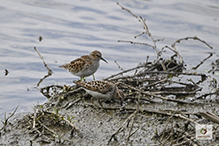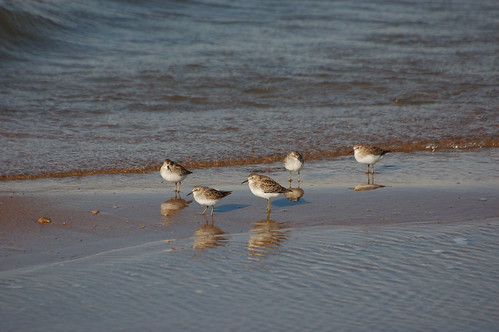Least Sandpiper
(Calidris minutilla)
Conservation • Description • Habitat • Ecology • Distribution • Taxonomy
Conservation Status |
|
|||||||
| IUCN Red List | LC - Least Concern |
|||||||
| NatureServe | N5B, N5N - Secure Breeding and Nonbreeding SNRM - Unranked Migrant |
|||||||
| Minnesota | not listed |
|||||||
Description |
||
Least Sandpiper is a common, small shorebird. It nests in northern Canada and Alaska in mossy or grassy tundra or shrubby bogs, always near water. In the spring it migrates south to the southern United States, Central America, and northern South America. It is a common migrant in Minnesota from mid-April to early June and from early July to October. During migration it is found in marshes and flooded or wet fields, on mudflats and shores of lakes and pools, and occasionally on beaches. It is usually seen in small groups, not large flocks. Least Sandpiper is the smallest shorebird in North America. Adults are 5⅛″ to 5⅞″ (13 to 15 cm) in length, have a 10⅝″ to 11″ (27 to 28 cm) wingspan, and weigh 0.7 to 1.1 oz (19 to 30 g). Males and females are the same size. The body is round and relatively short. The wings are short and pointed. The overall coloration is darker than other small shorebirds, a feature that makes identification relatively easy. The upperparts, the back, wings, tail, and the crown of the head, are mottled dark brown and reddish-brown. The underparts are white. The head and nape of the neck are buff brown. The breast is buff brown and prominently streaked. The bill is short, thin, pointed, and slightly curved downward. The legs are moderately short. They are greenish-yellow but often appear dark in low light or when smeared with mud. |
||
Size |
||
Length: 5⅛″ to 5⅞″ (13 to 15 cm) Wingspan: 10⅝″ to 11″ (27 to 28 cm) Weight: 0.7 to 1.1 oz (19 to 30 g) |
||
Voice |
||
The voice is a high pitched kreee or rolling greeep. |
||
Similar Species |
||
Habitat |
||
|
||
Ecology |
||
Migration |
||
Mid-April to early June and early July to October |
||
Nesting |
||
|
||
Food |
||
Small insects, crustaceans, small mollusks, worms, and occasionally seeds |
||
Distribution |
||||
Occurrence |
||||
Common migrant |
||||
Maps |
||||
The Minnesota Ornithologists’ Union All Seasons Species Occurrence Map |
||||
Taxonomy |
|||
| Class | Aves (birds) | ||
Order |
Charadriiformes (shorebirds and allies) | ||
Family |
Scolopacidae (sandpipers and allies) | ||
Genus |
Calidris (stints) | ||
Subordinate Taxa |
|||
|
|||
Synonyms |
|||
Tringa minutilla |
|||
Visitor Photos |
|||||
Share your photo of this bird. |
|||||
| This button not working for you? Simply email us at info@MinnesotaSeasons.com. Attach one or more photos and, if you like, a caption. |
|||||
Mike Poeppe |
|||||
 |
|||||
MinnesotaSeasons.com Photos |
|||||
|
|||||

Visitor Videos |
|||
Share your video of this bird. |
|||
| This button not working for you? Simply email us at info@MinnesotaSeasons.com. Attach a video, a YouTube link, or a cloud storage link. |
|||
Other Videos |
|||
| Least Sandpiper (Calidris minutilla) Birds In Motion |
|||
About
Oct 23, 2021 |
|||
| Least Sandpiper - calidris minutilla SouthwestBirdsTV |
|||
About
Feb 17, 2022 Close-up of Least Sandpiper eating insects. Northern Mockingbird, grackle and sparrow bird sounds in the background. |
|||
| Least Sandpiper (Scolopacidae: Calidris minutilla) Carl Barrentine |
|||
About
Jul 23, 2009 hotographed at Kellys Slough NWR, North Dakota (23 July 2009). |
|||
| Least Sanpiper Wild Bird and Nature Videos by McElroy Productions |
|||
About
Sep 3, 2011 A least sandpiper feeding on insects during fall migration in Maine. © 2011 Garth McElroy |
|||

Created: 5/31/2023
Last Updated:




